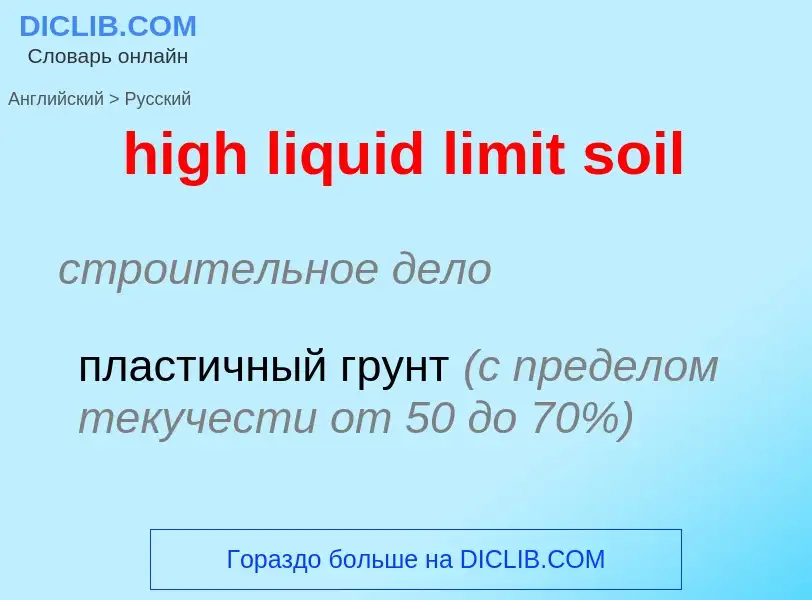Μετάφραση και ανάλυση λέξεων από τεχνητή νοημοσύνη
Σε αυτήν τη σελίδα μπορείτε να λάβετε μια λεπτομερή ανάλυση μιας λέξης ή μιας φράσης, η οποία δημιουργήθηκε χρησιμοποιώντας το ChatGPT, την καλύτερη τεχνολογία τεχνητής νοημοσύνης μέχρι σήμερα:
- πώς χρησιμοποιείται η λέξη
- συχνότητα χρήσης
- χρησιμοποιείται πιο συχνά στον προφορικό ή γραπτό λόγο
- επιλογές μετάφρασης λέξεων
- παραδείγματα χρήσης (πολλές φράσεις με μετάφραση)
- ετυμολογία
high liquid limit soil - translation to ρωσικά
строительное дело
пластичный грунт (с пределом текучести от 50 до 70%)
общая лексика
жидкостная хроматография высокого разрешения
Ορισμός
Βικιπαίδεια
The Atterberg limits are a basic measure of the critical water contents of a fine-grained soil: its shrinkage limit, plastic limit, and liquid limit.
Depending on its water content, soil may appear in one of four states: solid, semi-solid, plastic and liquid. In each state, the consistency and behavior of soil are different, and consequently so are its engineering properties. Thus, the boundary between each state can be defined based on a change in the soil's behavior. The Atterberg limits can be used to distinguish between silt and clay and to distinguish between different types of silts and clays. The water content at which soil changes from one state to the other is known as consistency limits, or Atterberg's limit.
These limits were created by Albert Atterberg, a Swedish chemist and agronomist, in 1911. They were later refined by Arthur Casagrande, an Austrian-born American geotechnical engineer and a close collaborator of Karl Terzaghi (both pioneers of soil mechanics).
Distinctions in soils are used in assessing soil which is to have a structure built on them. Soils when wet retain water, and some expand in volume (smectite clay). The amount of expansion is related to the ability of the soil to take in water and its structural make-up (the type of minerals present: clay, silt, or sand). These tests are mainly used on clayey or silty soils since these are the soils which expand and shrink when the moisture content varies. Clays and silts interact with water and thus change sizes and have varying shear strengths. Thus these tests are used widely in the preliminary stages of designing any structure to ensure that the soil will have the correct amount of shear strength and not too much change in volume as it expands and shrinks with different moisture contents.



![[[HILIC]] Partition Technique Useful Range [[HILIC]] Partition Technique Useful Range](https://commons.wikimedia.org/wiki/Special:FilePath/HILIC Partition Method Graphic.png?width=200)


.jpg?width=200)
